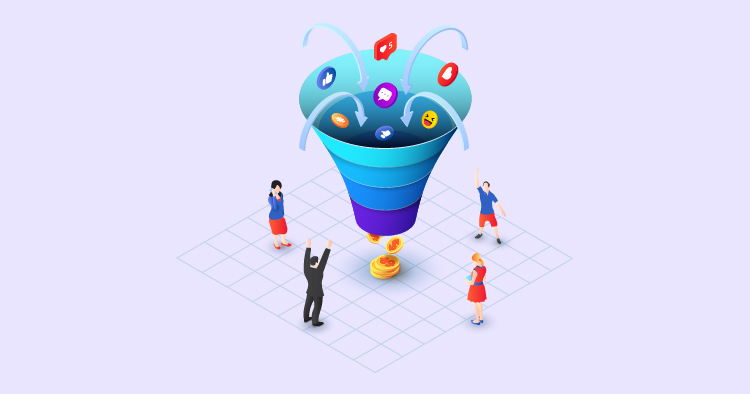Sales funnels are critical for businesses looking to convert prospects into loyal customers. By understanding the various sales funnels, companies can tailor their marketing strategies to more effectively guide potential clients through buying. Each funnel type addresses specific customer behaviors and preferences from the awareness stage to the final purchase decision. This article delves into the most common and innovative sales funnel models, highlighting their unique features and how they can be applied to various business scenarios to drive sales and foster customer engagement.
Understanding Sales Funnels
A sales funnel is a way to understand a customer’s steps, from discovering your product or service to buying it. It’s like a roadmap for businesses to see how to convert someone just looking into a paying customer. By knowing what customers think and do at each step, companies can make better plans to get their attention, keep them interested, and convince them to buy.
Sales funnels are essential for growing your business. They help you ensure you’re talking to the right people at the right time so you don’t waste effort on those who aren’t interested. When you get good at guiding people through the funnel, you’ll probably see more sales, and your business will grow.
The sales funnel is critical to getting more people to buy your stuff. It’s all about giving each potential customer the right nudge at the right time so they keep moving closer to buying. A well-made sales funnel doesn’t just grab people’s attention; it also keeps them hooked and makes them want to buy, which means you’ll sell more.
Traditional Sales Funnel
The old-school sales funnel has been around for a while and breaks down the buying process into a few straightforward steps. It’s like a straight path that people follow: they start by finding out about your product, then they get curious, decide if it’s right for them, and finally, they buy it.
Awareness: This is when people first hear about what you’re selling.
Interest: Now they’re curious and want to learn more.
Decision: They’re thinking hard about buying your product or someone else’s.
Struggling with Digital marketing? Book Your Free Strategy Session!
- 30-Minutes Session
- Expert Insights
- Data-Driven approach
- Optimized Strategies for Your Goals
Action: This is when they buy what you’re selling.
If you want to maximize the traditional sales funnel, get the word out with great marketing, give people the information they need to get interested, offer something tempting to help them decide, and make buying as easy as pie. That way, more people will end up buying from you.
Linear Sales Funnel
A linear sales funnel is a simple method businesses use to turn potential customers into buyers. It’s like walking down a straight path where each step—awareness, interest, decision, and action—leads directly to the next. Think of it as a one-way street to move forward without any detours.
This approach is excellent for products or services that don’t need a lot of explanation or when the buying process is quick and easy. It’s like having a map that shows you the fastest route from Point A to Point B. But here’s the catch: not everyone likes to travel the same way or at the same speed. Some people might want to take a different route or stop to look around before they buy, and the linear funnel doesn’t always allow for that.
So, while the linear sales funnel is excellent for its simplicity and ease of implementation, it might not fit every business, especially if your customers need more time or like to shop around before they make a decision.
Multi-Channel Sales Funnel
Now, imagine a sales funnel that’s more like a spider web. A multi-channel sales funnel doesn’t just lead potential customers down a single path; it connects with them in many different ways and places. Today, people use various channels to shop and interact with brands—social media, email, blogs, in-person stores, and more. A multi-channel funnel is about meeting customers where they are and providing a seamless experience, no matter how they come across your product.
The beauty of this approach is that it can reach more people in ways they prefer, leading to better engagement and a stronger connection with your brand. For example, someone might see your product on Instagram, read about it on your blog, and finally get a reminder about it in an email. This strategy ensures your message is everywhere your customers are, giving them plenty of opportunities to learn about and buy your products.
However, it’s not without its challenges. It’s challenging to keep your message consistent across all these channels and ensure they all work together. It’s like being an orchestra conductor—every instrument must play harmoniously to create beautiful music. But when done right, a multi-channel sales funnel can be a powerful way to grow your business and keep your customers happy.
Reverse Sales Funnel
The reverse sales funnel takes a different approach than what most of us are used to. Traditional sales funnels cast a wide net to catch as many new customers as possible. The reverse sales funnel, however, starts at the other end. It focuses on the customers you already have, aiming to keep them around for the long haul and encourage them to buy more or tell their friends about your business.
Struggling with Digital marketing? Book Your Free Strategy Session!
- 30-Minutes Session
- Expert Insights
- Data-Driven approach
- Optimized Strategies for Your Goals
This customer-first strategy is about building stronger bonds with those who have already bought from you. It’s about showing them you value their business and want to keep them happy. Happy customers are more likely to return and might even bring new customers through referrals.
One of the significant advantages of this approach is that it can save you money. It’s usually cheaper to keep an existing customer than to find a new one. By concentrating on the customers you already have, you can boost your sales while keeping your costs down.
Webinar Sales Funnel
Webinars are powerful tools for businesses that must explain their products or services in depth. With a webinar sales funnel, you use these online presentations to draw in potential customers and give them the information they need to decide.
Here’s how it works: You start by getting the word out about your webinar to attract people. Then, during the webinar, you keep them engaged by sharing helpful information that speaks directly to their needs and challenges. After the webinar, you stay in touch with the attendees, guiding them toward the next steps they can take with your business.
To ensure your webinar turns attendees into customers, making it truly valuable to them is essential. Address their problems and offer solutions. And don’t forget to be clear about what you want them to do next with a solid call to action. After the webinar, follow-up emails are a great way to keep the conversation going, provide more helpful resources, and gently steer them toward a purchase.
Email Sales Funnel
Email sales funnels are crucial for connecting with potential customers meaningfully. Think of it as a conversation via email, where you’re getting to know your leads, and they’re getting to know your brand. You start by getting people to sign up for emails, often through an enticing offer on your website. Once they’re on your list, you can get to know them better by looking at their interests and behavior.
With this insight, you can email them about their needs and interests. It’s like having a series of chats, gradually helping them understand why your product is just what they’ve been looking for. The key is to make these emails feel personal, provide them with beneficial content, and avoid overly aggressive sales pitches.
To improve your email funnel, pay attention to what’s working and what’s not. Look at how many people open your emails and click on links. This will tell you a lot about what they like. Remember, the goal is to ensure each email adds value to their day, which can lead to better engagement and more sales.
Social Media Sales Funnel
Social media sales funnels are all about using the social platforms where your potential customers hang out to draw them in and keep them interested. It’s a more interactive approach where you can have real-time conversations and build a community around your brand.
To make the most of social media, create content your audience finds interesting, entertaining, or informative. Use the unique features social platforms offer, like short-lived Instagram stories or real-time Facebook videos, to give your audience a peek into your brand’s world. Chatting with followers, replying to their comments, and messaging them back help them feel connected and valued, which can encourage them to move closer to making a purchase.
Businesses that do well on social media often have a plan for what kind of content to post and when. They might work with influencers who can get the word out to even more people or run ads targeted to just the right audience. Many success stories show how these strategies can increase a brand’s popularity, get more people talking and interacting, and increase sales.
Content Marketing Sales Funnel
A content marketing sales funnel draws people in with valuable and engaging material and gently leads them to purchase. It is a helpful guide that shows potential customers how your product or service can solve their problems or improve their lives.
Knowing your audience is crucial to building a successful content marketing funnel. What do they want? What keeps them up at night? Once you understand this, you can create a mix of content–helpful blog posts, eye-catching videos, and easy-to-understand infographics–that speaks directly to them at each stage of their journey.
Imagine someone just starting to realize they have a problem. They might find one of your educational blog posts and think, “Hey, this company gets it!” They might dig into one of your detailed guides as they get more serious about finding a solution. And when they’re almost ready to buy, a success story or a glowing review from another customer might be just the nudge they need.
Landing Page Sales Funnel
A landing page sales funnel is all about focus. You create a laser-targeted webpage to get visitors to take one specific action, whether joining your email list or buying your latest gadget. This page is the show’s star, where all your marketing efforts converge.
When designing a landing page, clarity is critical. You want your message to be crystal clear, and you want your visitors to know exactly what to do. A big, bold call-to-action button that says “Sign up now” or “Buy today” can make all the difference. The design should be clean and straightforward so nothing distracts from your key message.
To ensure your landing page is as effective as possible, you can test different versions to see what works best. Maybe one headline is more persuasive, or another image gets more clicks. Showing positive customer feedback and creating a sense of urgency with a limited-time offer can encourage people to take the leap and convert.
E-commerce Sales Funnel
Companies tailor e-commerce sales funnels for online shopping experiences. They guide potential customers from the moment they discover a product to the point where they complete a purchase. Knowing what customers want and how they shop online is critical to making these funnels work well.
To create a funnel that converts visitors into customers and draws them in with solid search engine optimization (SEO) and engaging ads. Then, ensure that you display your products in a manner that is appealing and easy to understand. The overall shopping experience should be smooth, with a hassle-free checkout process. Little perks like free shipping or discounts can make a big difference in getting someone to complete their purchase.
Sometimes, shoppers add items to their cart but don’t finish buying them. This is commonly referred to as shopping cart abandonment, a common hurdle. To bring these shoppers back, you can use targeted ads that remind them of what they left behind, pop-ups that offer a deal if they complete the purchase, or follow-up emails. Trust is also a significant factor in online shopping. Showcasing customer reviews and good ratings can help new customers feel more confident about buying from you.
Affiliate Marketing Sales Funnel
Affiliate marketing funnels tap into the power of partnerships to boost sales. You can reach more people by teaming up with others who can promote your products. Earning a commission for the sales or leads they generate motivates affiliates, and they often have the trust of their audience, leading to more effective promotions.
Choose affiliates who get your brand and can speak to your target customers to make the most of affiliate marketing. Give them great content and tools for promotion, and ensure they’re rewarded fairly for their efforts. It’s also important to monitor how your affiliate campaigns are doing so you can make improvements.
Finding the best partners for your affiliate program means looking for people or companies with a following who would be interested in your offer. Clear communication and set guidelines help keep these relationships strong. When both sides understand each other and work together well, it’s a win-win situation.
Mobile Sales Funnel
Smartphones have revolutionized the way we shop. As more people browse and buy on their mobile devices, creating a sales funnel that works well on phones is no longer optional—it’s crucial. A mobile sales funnel ensures that customers have a smooth experience from discovering your product to making a purchase on handheld devices.
To make a sales funnel mobile-friendly, start by making sure your website looks good and works well on various screen sizes. This is called responsive design. Pages should load fast because mobile users are often on the go and won’t wait around. Navigation should be straightforward, with buttons and links that are easy to tap with a thumb.
When it’s time to buy, the checkout process should be as simple as possible. Reduce the number of steps to purchase and offer payment options that are easy to use on mobile, like digital wallets.
There are also mobile-specific strategies to consider. SMS marketing can directly reach customers, and local search optimization helps nearby shoppers find you. Mobile apps can offer a more personalized shopping experience. Don’t forget to include a click-to-call option for immediate service and use email templates that look great on mobile screens.
Hybrid Sales Funnel
A hybrid sales funnel is like a Swiss Army knife for your marketing strategy—it combines the best tools from different approaches to fit your customers’ diverse needs. This type of funnel doesn’t limit itself to one tactic but uses a mix of email, social media, content marketing, and more to guide potential customers toward a purchase.
For example, you might use engaging blog posts to attract visitors to your site, then capture their email addresses to keep them informed and interested through regular updates. Or you could use targeted social media ads to draw people to an optimized landing page to convert them into leads or customers.
The power of a hybrid funnel is in its flexibility. It allows you to engage with customers in various ways, which can be especially effective given your audience’s wide range of preferences and behaviors. Combining these methods means you can nurture leads with informative content, build relationships on social media, and close sales with targeted offers—all within the same funnel.
Looking at successful case studies, we see businesses thriving by mixing and matching these strategies. These success stories can be a goldmine of ideas, showing you how to blend different tactics to create a funnel that’s more than the sum of its parts, ultimately leading to increased conversions and sales.
Final Thoughts
The effectiveness of a sales funnel hinges on its alignment with the target audience and the business’s goals. As we’ve explored the different sales funnels, it’s clear that there’s no one-size-fits-all solution. Continual testing and optimization are essential for finding the proper funnel that resonates with your audience and maximizes conversion rates. By staying informed and adaptable, businesses can leverage the correct type of sales funnel to increase revenue and build lasting customer relationships.



